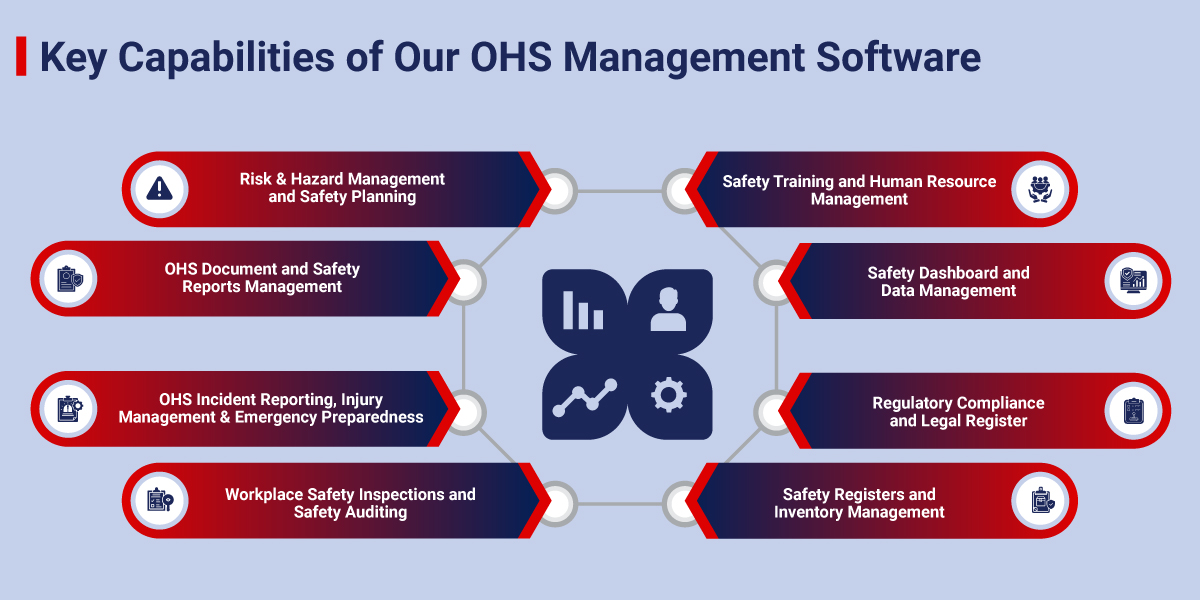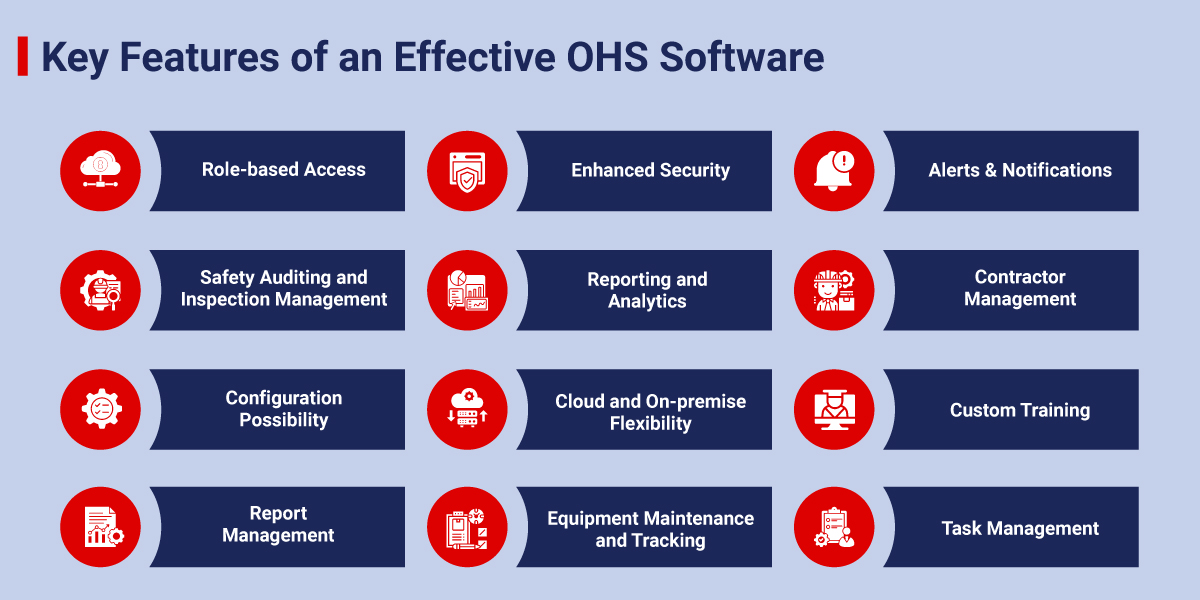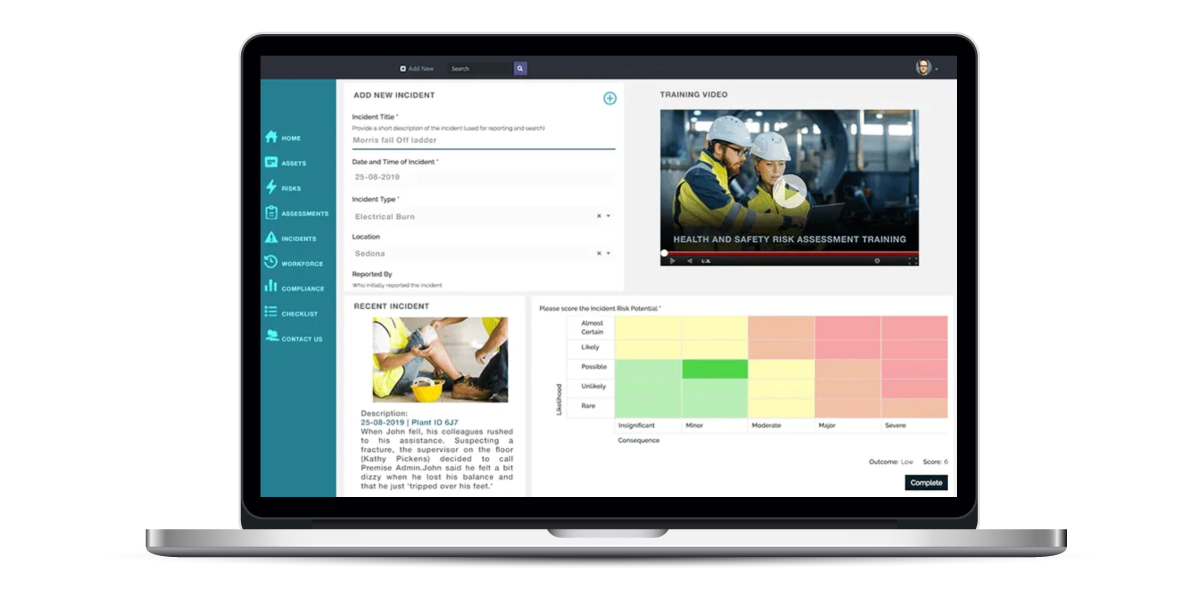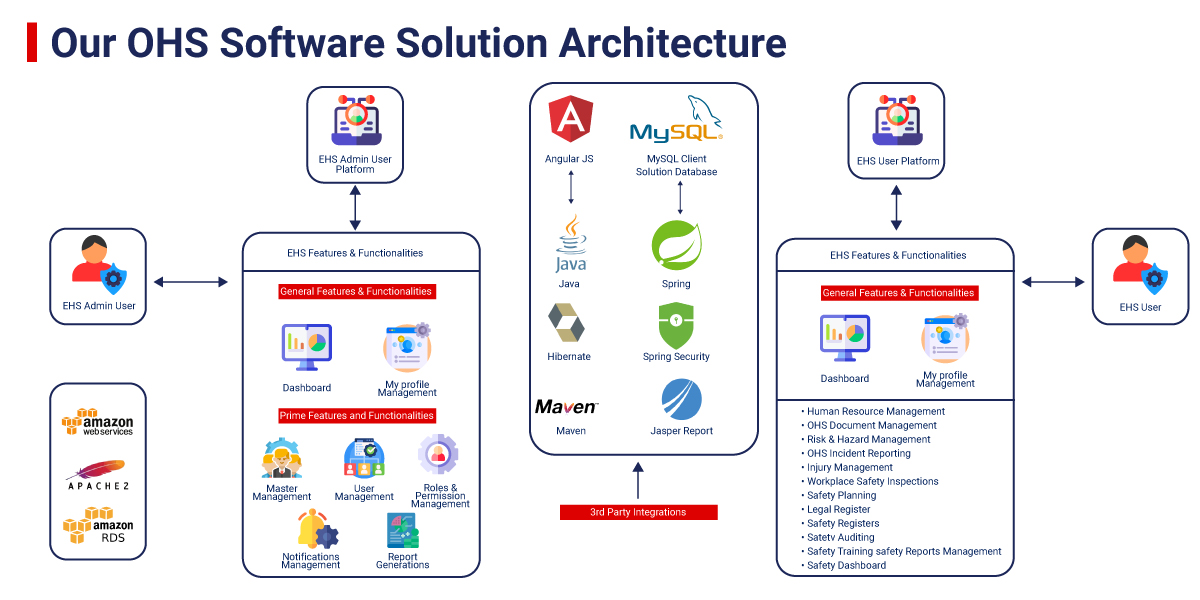2.6 million deaths are caused by work-related diseases, and work accidents add another 330,000 deaths worldwide.[1] The numbers highlight the urgency that today’s fast-paced workplace must prioritize an efficient health and safety management software to ensure that all the employees, sub-contractors, and contract workers operate in a safe work environment.
Creating a safe working environment can save you significant time, money, and most importantly, lives! The best way to monitor, manage, minimize, and mitigate risks is by integrating OHS management software. Whether it’s adhering to the ISO 45001 standard, the OSHA regulations in the US, the WHS Act in Australia, the OSH Act in Germany, or the HSW Act in the UK, OHS software can be customized to ensure global applicability for multinational organizations.
At Rishabh Software, we’ve developed a ready-to-implement occupational health and safety software that can be customized to address your specific challenges while ensuring a safe and compliant work environment. Read on to explore the key features and capabilities of this software and know how it can help you optimize workflows, enhance visibility and implement proactive safety measures. So, let’s get started!
Why Does Your Organization Need Occupational Health and Safety Software?
Our OHS solution helps reduce risk and ensure regulatory compliance organization-wide. It also offers the following benefits that far outweigh traditional paper-based systems.
- Enhanced compliance and regulatory adherence with various international and local health and safety regulations reduces the risk of legal penalties and enhances the organization’s reputation.
- Audit Readiness with detailed records of all safety-related activities and changes that are crucial for demonstrating compliance to external auditors.
- Improved risk management with integrated tools for identifying, assessing, and mitigating the risks of accidents and injuries.
- Streamlined reporting of incidents and near-misses backed by investigations and corrective actions helps to prevent future hazards.
- Centralized data management on an easily accessible platform ensures that information is always up-to-date and available for decision-making and auditing purposes.
- Automated workflow and task management of safety-related protocols and corrective actions.
- Real-Time monitoring and analytics on safety performance metrics facilitate immediate response to emerging safety issues.
- Cost benefits with automated manual processes and reduced worker compensation claims, legal fees, regulatory fines and insurance premiums due to fewer incidents and better risk management.
- Enhanced collaboration across departments to ensures that everyone is informed and aligned with safety protocols.
- Commitment to sustainable practices and corporate social responsibility by ensuring a safe and healthy work environment that improves public perception and stakeholder trust.
Integrating our OHS solution will build trust and confidence regarding your organization in the eyes of clients and employees concerned about safety. To ensure you make the most of the benefits of OHSMS, our team has integrated the following capabilities that efficiently address industry-specific risks and regulations.
Key Capabilities of Our Occupational Health and Safety Management Software
Let’s explore the crucial capabilities of our efficient and comprehensive occupational safety management solution:

Risk & Hazard Management and Safety Planning
- Risk & Hazard Management: End-users get tools to identify, assess, and reduce workplace hazards, creating a safer work environment.
- Safety Planning: Develop and execute safety plans to proactively manage risks and improve overall safety.
OHS Document and Safety Reports Management
- OHS Document Management: Simplify and secure all OHS documents, ensuring easy access and regulatory compliance.
- Safety Reports Management: Generate and analyze safety reports to monitor and enhance workforce safety performance.
OHS Incident Reporting, Injury Management & Emergency Preparedness
- Incident Reporting & Management: Efficiently report, track, and manage workplace incidents to prevent future occurrences.
- Injury Management: Manage employee injuries with timely care and effective recovery plans for a faster return to work.
- Emergency Preparedness: Create and implement emergency response plans to handle crises and minimize their impact.
Workplace Safety Inspections and Safety Auditing
- Safety Inspections: Conduct regular inspections to identify and fix potential hazards, ensuring a safe workplace.
- Safety Auditing: Perform detailed safety audits to meet regulatory standards and improve safety practices.
Safety Training and Human Resource Management
- Safety Training: Access comprehensive training programs to enhance employee safety knowledge and skills.
- Human Resource Management: Integrate safety management with HR processes for a cohesive approach to workplace safety.
Safety Dashboard and Data Management
- Safety Dashboard: View real-time safety metrics to make informed decisions and improve safety performance.
- Safety Data Management: Collect, store, and analyze safety data to continuously enhance safety measures.
Regulatory Compliance and Legal Register
- Regulatory Compliance: Ensure compliance with local and international safety regulations, avoiding fines and improving safety.
- Legal Register: Keep an up-to-date register of all legal safety requirements and standards relevant to your business.
Safety Registers and Inventory Management
- Safety Registers: Maintain detailed records of all safety activities, inspections, and audits for compliance tracking.
- Inventory Management: Manage stock levels of PPE and safety equipment to ensure availability and compliance.
Essential Features for an Effective OHS Software
Each organization has different needs and scope for specific features in their health & safety mix. As a standard consulting practice, our team can help analyze your project requirements, map the potential challenges, and work with you to develop the outcomes based on your chosen key features. Let’s explore the key features that make our ready-to-implement occupational health and safety software a vital tool for creating a safer work environment:

Role-based Access
- Controlled Access: Administrators can assign specific permissions and login access controls, ensuring users only access necessary information and functionalities.
Enhanced Security
- Control and manage access to your occupational safety software to maintain data security and integrity.
Alerts & Notifications
- Automated Alerts: Sends alerts and notifications based on predefined triggers like safety incidents, compliance deadlines, and upcoming training sessions.
- Critical Event Management: Stay informed of critical events to ensure timely responses and compliance.
Safety Auditing and Inspection Management
- Streamlined Audits: Enable facility managers to schedule, conduct, and document audits and inspections related to occupational health and safety.
- Inspection Management: Generate comprehensive audit and inspection reports with options for customization and data visualization. Schedule follow-up audits/inspections based on identified non-conformities or risk levels.
Reporting and Analytics
- Centralized Dashboard: Visualize key safety metrics, performance indicators, and trends with a comprehensive dashboard.
- In-depth Analysis: Utilize robust analytics tools to generate reports, analyze data, and gain actionable insights into safety performance.
Contractor Management
- Track External Contractors: Manage and monitor the activities of on-site contractors and vendors, including qualification, onboarding, and compliance.
- Compliance Tracking: Ensure all contractors meet safety and compliance standards.
Configuration Possibility
- Customizable Workflows: Tailor the OHS management solution to industry-specific workflows and processes by adjusting settings and adding custom fields.
- Flexible Settings: Define workflows that match your organization’s unique needs and preferences.
Cloud & On-Premise Flexibility
- Deployment Options: Choose between cloud-based or on-premise deployment models to fit your organization’s preferences, requirements, and infrastructure capabilities.
- Scalable Solutions: Opt for the deployment that best suits your operational needs and scalability.
Custom Training
- Personalized Programs: Create and deliver training programs tailored to industry-specific safety requirements and job roles.
- Track Progress: Use customizable templates to design training modules, monitor employee progress, and assess learning outcomes.
Report Management
- Customizable Reports: Generate and manage various types of reports related to safety incidents, inspections, audits, and compliance activities.
- Insight Sharing: Easily share insights with stakeholders to keep everyone informed and engaged.
Equipment Maintenance and Tracking
- Maintenance Schedules: Manage and track equipment maintenance schedules and inspection records efficiently.
- Performance Monitoring: Keep accurate records of equipment inspections and maintenance history to ensure operational reliability.
Task Management
- Streamlined Workflows: Automate task assignments, set deadlines, monitor progress, and ensure accountability for safety-related responsibilities.
- Efficiency and Accountability: Improve workflow efficiency and ensure all safety tasks are completed on time.
As an experienced company in enterprise software development, Rishabh Software is your reliable partner in building and implementing OHS risk management software tailored to your needs. Discover how we helped an Australia-based OHS software solution & consulting company enhance employee safety and minimize occupational hazards by automating workflows.
Success Story: Transforming Workplace Safety with Cloud-Based Occupational Health and Safety Software
Our client sought a robust solution to streamline risk and compliance management within their workplace. They wanted to implement a unified platform capable of seamlessly monitoring multiple worksite locations and transient workers.

Key Challenges
- Lack of a centralized system to identify and register workplace hazards accurately
- Inefficient tracking of employee competencies and training requirements
- Inability to manage compliance and risks across multiple client sites effectively
- Manual processes hindered accurate and timely reporting of incidents and audits
To address these challenges, we developed a comprehensive, cloud-based OHS management solution. This platform enabled the client to take control of their workplace safety programs while ensuring compliance, reducing risks, and creating a culture of continuous improvement.
Key Features
- A centralized platform for audits, compliance, risk management, training, and document control.
- Custom training programs tailored to specific needs.
- Automated workflows for incident reporting, hazard identification, and corrective action assignment.
- Comprehensive dashboards and customizable reports to generate deep insights into key performance indicators.
Transformative Impact
By partnering with Rishabh Software and implementing the occupational health management software, the client realized significant benefits, including:
- 40% increase in worker participation and engagement in safety programs
- 28% reduction in insurance premiums and legal costs associated with workplace incidents
- 3x increase in profitability due to the elimination of health and safety risks
This workplace health and safety software development case study illustrates how integrating this OHS solution boosted stakeholder confidence in the organization’s commitment to occupational health and safety.
How Can Rishabh Software Help You Implement an OHS Solution for Optimized Workflows and Enhanced Visibility?
From tracking incidents and ensuring regulatory compliance to identifying and mitigating risks – our customizable OHS management software solution can be tailored to your specific regulatory requirements and internal audit checklist. The unified, comprehensive, cloud-based health and safety software is designed to meet the unique needs of Health and Safety Managers, Operations Managers, Risk and Compliance Officers, and Business Leaders. Here’s why:

- Built on a modular architecture, our ready application framework allows for swift and seamless integration with your existing systems and workflows.
- With customizable and scalable features, you can tailor the platform to suit your specific compliance requirements.
- Advanced reporting and analytics capabilities provide actionable insights for data-driven decision-making.
- Robust security and compliance features ensure the protection of your sensitive information.
- It automates manual processes and gives you full visibility into safety operations with streamlined workflows and centralized information.
Frequently Asked Questions
Q: Which industries can benefit from OHS management software development?
A: The following industries stand to gain the most out of OHS software:
Healthcare
- Manage infection control protocols
- Track staff training.
- monitor ergonomic risks, biological hazards, and patient handling injuries.
Construction
- Track safety training, equipment inspections, and hazard reporting.
- Streamline incident reporting and investigation for falls, struck-by incidents, electrocution, or trench collapses.
Manufacturing
- Oversee equipment maintenance, risk assessments, and chemical inventories.
- Address and avert machinery accidents, chemical exposure, ergonomic issues, and noise pollution.
Transportation and Logistics
- Monitor driver safety training and vehicle maintenance.
- Manage fatigue risks to avoid vehicle accidents, slips and falls, and hazards associated with material handling.
Pharmaceuticals and Chemicals
- Management of chemical inventories, safety data, and risk assessments.
- Prevent hazardous conditions like chemical exposure, fires, and explosions.
Utilities (Water, Electricity, Gas)
- Regulate equipment maintenance, safety procedures, and risk assessments
- Ensure safety against electrical shocks, chemical exposure, and confined space entry.
Q: What are the emerging trends and innovations in OHS software development?
A: The most recent trends in occupational health and safety software development include:
- Cloud Computing and SaaS OHS platforms for leveraging benefits like remote access, scalability, and easier updates at reduced IT infrastructure costs.
- Mobile Applications for enabling real-time incident reporting, safety inspections, and training delivery on the go.
- IoT and Wearables to monitor environmental conditions, worker vitals, and equipment performance in real-time for early hazard detection, proactive safety interventions, and predictive maintenance.
- AI and ML to analyze datasets and identify patterns, predict hazards, and optimize safety protocols.
- Big Data Analytics and Predictive Modeling to identify trends, correlations, and leading indicators of safety performance for proactive risk management.
Q: What post-implementation support and maintenance services does Rishabh Software provide for occupational health and safety software?
A: Rishabh Software offers comprehensive post-implementation support and maintenance services for OHSMS that include:
- Prompt technical assistance to address any issues that may arise with the OHS software. This support ensures smooth operation and minimal downtime for the solution.
- Regular updates and upgrades that are essential to keep the OHS software aligned with changing regulatory requirements and industry standards.
- SLAs that outline the agreed-upon response times, service availability, and performance metrics for support and maintenance services.
- Customization services to tailor the software according to specific needs and feature enhancements to improve its performance and usability over time.
- Expert consulting and advisory services to optimize OHS processes and implement best practices.
Footnotes:
1. https://www.ilo.org/resource/news/nearly-3-million-people-die-work-related-accidents-and-diseases#










 30 Min
30 Min


